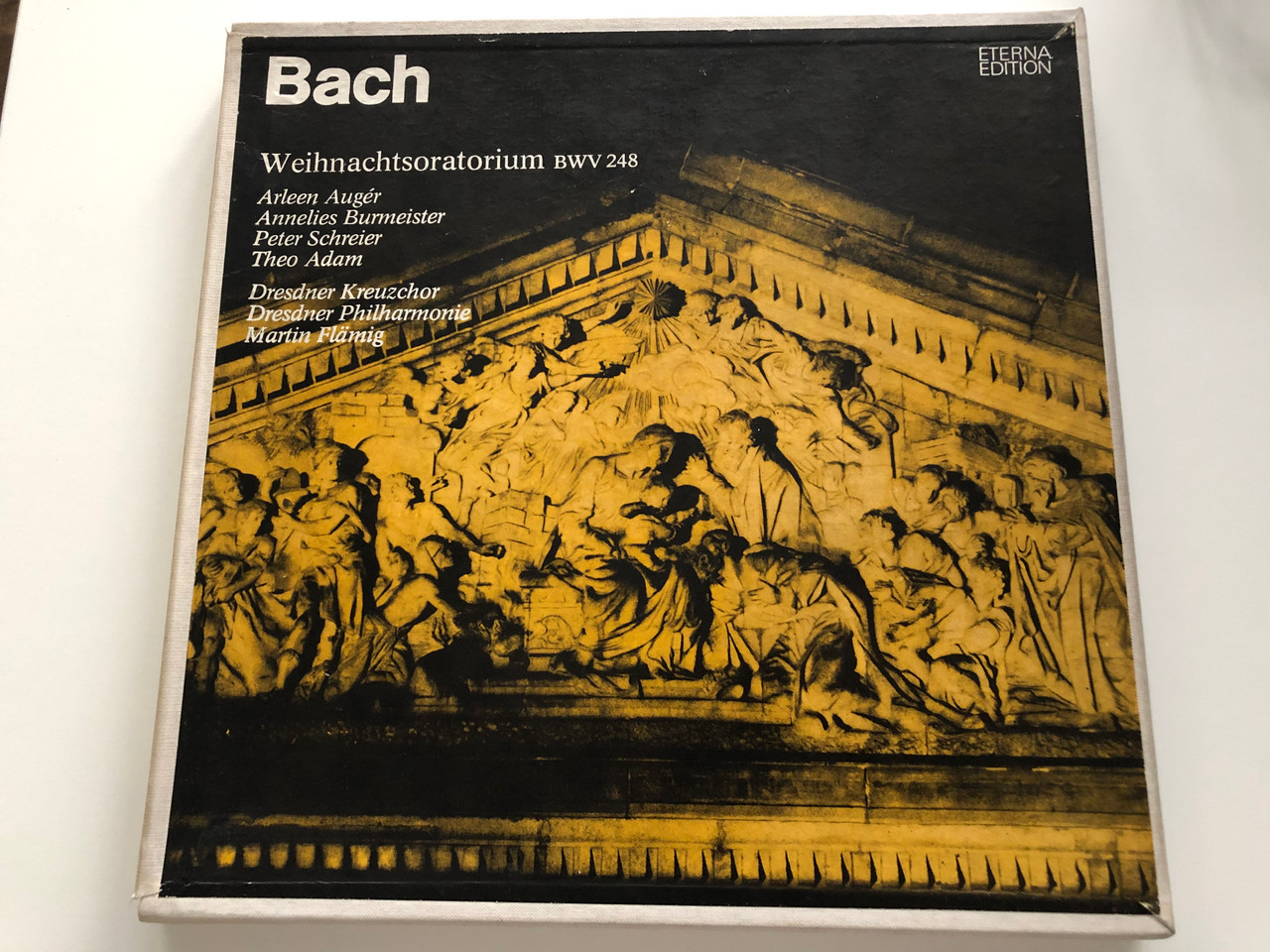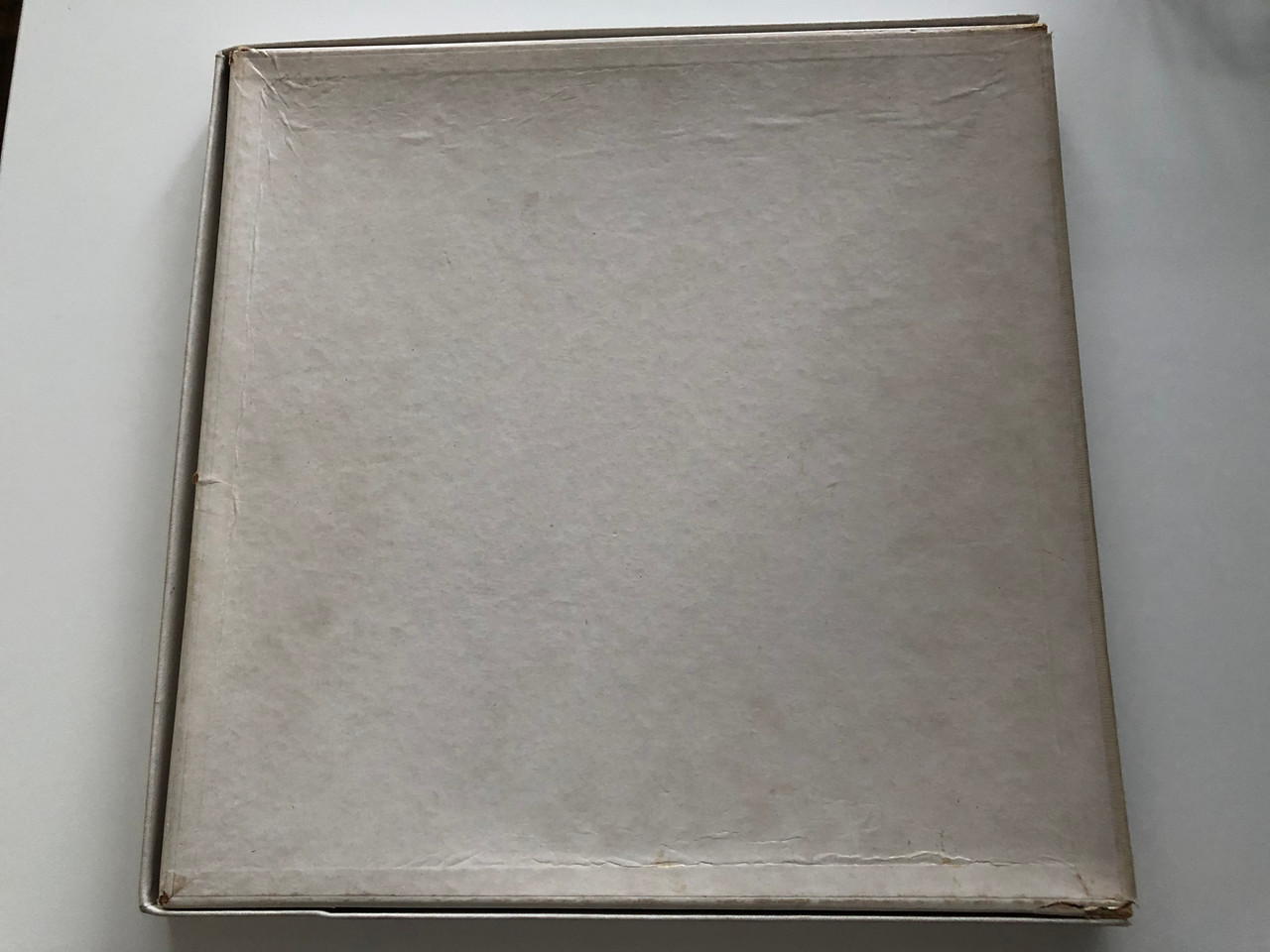Description
Bach - Weihnachtsoratorium BWV 248 / Arleen Augér, Annelis Burmeister, Peter Schreier, Theo Adam / Dresdner Kreuzchor, Dresdner Philharmonie, Martin Flämig / ETERNA Edition / ETERNA 3x LP Stereo
8 25 084-087
The Christmas Oratorio (German: Weihnachts-Oratorium), BWV 248, is an oratorio by Johann Sebastian Bach intended for performance in church during the Christmas season. It was written for the Christmas season of 1734 and incorporates music from earlier compositions, including three secular cantatas written during 1733 and 1734 and a largely lost church cantata, BWV 248a. The date is confirmed in Bach's autograph manuscript. The next performance was not until 17 December 1857 by the Sing-Akademie zu Berlin under Eduard Grell. The Christmas Oratorio is a particularly sophisticated example of parody music. The author of the text is unknown, although a likely collaborator was Christian Friedrich Henrici (Picander).
The work belongs to a group of three oratorios written in 1734 and 1735 for major feasts, the other two works being the Ascension Oratorio (BWV 11) and the Easter Oratorio (BWV 249). All three of these oratorios to some degree parody earlier compositions. The Christmas Oratorio is by far the longest and most complex work of the three.
The Christmas Oratorio is in six parts, each part being intended for performance on one of the major feast days of the Christmas period. The piece is often presented as a whole or split into two equal parts. The total running time for the entire work is nearly three hours.
The first part (for Christmas Day) describes the Birth of Jesus, the second (for December 26) the annunciation to the shepherds, the third (for December 27) the adoration of the shepherds, the fourth (for New Year's Day) the circumcision and naming of Jesus, the fifth (for the first Sunday after New Year) the journey of the Magi, and the sixth (for Epiphany) the adoration of the Magi.
Tracklist:
| Erster Teil | |||
| A1 | Nr. 1 Chor | ||
| A2 | Nr. 2 Rezitativ - Evangelist (Tenor) | ||
| A3 | Nr. 3 Rezitativ - Alt | ||
| A4 | Nr. 4 Arie - Alt | ||
| A5 | Nr. 5 Choral | ||
| A6 | Nr. 6 Rezitativ - Evangelist | ||
| A7 | Nr. 7 Choral Und Rezitativ - Chorsopran Und Bass | ||
| A8 | Nr. 8 Arie - Bass | ||
| A9 | Nr. 9 Choral | ||
|
Zweiter Teil |
|||
| B1 | Nr. 10 Sinfonia (Hirtenmusik) | ||
| B2 | Nr. 11 Rezitativ - Evangelist | ||
| B3 | Nr. 12 Choral | ||
| B4 | Nr. 13 Rezitativ - Evangelist / Der Engel (Sopran) | ||
| B5 | Nr. 14 Rezitativ - Bass | ||
| B6 | Nr. 15 Arie - Tenor | ||
| B7 | Nr. 16 Rezitativ - Der Engel | ||
| B8 | Nr. 17 Choral | ||
| B9 | Nr. 18 Rezitativ - Bass | ||
| B10 | Nr. 19 Arie - Alt | ||
| B11 | Nr. 20 Rezitativ - Evangelist | ||
| B12 | Nr. 21 Chor | ||
| B13 | Nr. 22 Rezitativ - Bass | ||
| B14 | Nr. 23 Choral | ||
|
Dritter Teil |
|||
| C1 | Nr. 24 Chor | ||
| C2 | Nr. 25 Rezitativ - Evangelist | ||
| C3 | Nr. 26 Chor | ||
| C4 | Nr. 27 Rezitativ - Bass | ||
| C5 | Nr. 28 Choral | ||
| C6 | Nr. 29 Duett - Sopran Und Bass | ||
| C7 | Nr. 30 Rezitativ - Evangelist | ||
| C8 | Nr. 31 Arie - Alt | ||
| C9 | Nr. 32 Rezitativ - Alt | ||
| C10 | Nr. 33 Choral | ||
| C11 | Nr. 34 Rezitativ - Evangelist | ||
| C12 | Nr. 35 Choral | ||
| C13 | Wiederholung Von Chor Nr. 24 | ||
|
Vierter Teil |
|||
| D1 | Nr. 36 Chor | ||
| D2 | Nr. 37 Rezitativ - Evangelist | ||
| D3 | Nr. 38 Rezitativ Und Choral - Bass / Sopran UNd Bass / Bass | ||
| D4 | Nr. 39 Arie - Sopran Und Echo-Sopran | ||
| D5 | Nr. 40 Rezitativ Mit Choral - Rezitativ (Bass) / Arioso (Sopran) | ||
| D6 | Nr. 41 Arie - Tenor | ||
| D7 | Nr. 42 Choral | ||
|
Fünfter Teil |
|||
| E1 | Nr. 43 Chor | ||
| E2 | Nr. 44 Rezitativ - Evangelist |
| E3 | Nr. 45 Chor Und Rezitativ - Chor Und Alt | ||
| E4 | Nr. 46 Choral | ||
| E5 | Nr. 47 Arie - Bass | ||
| E6 | Nr. 48 Rezitativ - Evangelist | ||
| E7 | Nr. 49 Rezitativ - Alt | ||
| E8 | Nr. 50 Rezitativ - Evangelist | ||
| E9 | Nr. 51 Terzett - Sopran / Tenor / Alt / Sopran Und Tenor |
||
| E10 | Nr. 52 Rezitativ - Alt | ||
| E11 | Nr. 53 Choral | ||
|
Sechster Teil |
|||
| F1 | Nr. 54 Chor | ||
| F2 | Nr. 55 Rezitativ - Evangelist / Herodes (Bass) | ||
| F3 | Nr. 56 Rezitativ - Sopran | ||
| F3 | Nr. 57 Arie - Sopran | ||
| F4 | Nr. 58 Rezitativ - Evangelist | ||
| F5 | Nr. 59 Choral | ||
| F6 | Nr. 60 Rezitativ - Evangelist | ||
| F7 | Nr. 61 Rezitativ - Tenor | ||
| F8 | Nr. 62 Arie - Tenor | ||
| F9 | Nr. 63 Rezitativ - Sopran, Alt, Tenor, Bass | ||
| F10 | Nr. 64 Choral |
- Alto Vocals – Annelies Burmeister
- Artwork [Uncredited; Sculpture; Tympanon, Hedwigskathedrale Berlin] – Georg Wenzeslaus von Knobelsdorff
- Bass Vocals – Theo Adam
- Bassoon – Günter Klier
- Choir – Dresdner Kreuzchor
- Composed By – Johann Sebastian Bach
- Conductor – Martin Flämig
- Contrabassoon – Heinz Schmidt
- Cornet [Da Caccia, 1st] – Lothar Böhm
- Cornet [Da Caccia, 2nd] – Karl-Heinz Brückner
- Design [Gestaltung] – Christoph Ehbets
- Editor – Erika Krökel
- Engineer [Tonregie] – Claus Strüben, Horst Kunze
- Flute [Solo, 1st] – Eckart Haupt
- Flute [Solo, 2nd] – Wolfgang Peschke
- Liner Notes – Hansjürgen Schaefer, Johanna Rudolph
- Music Director – Heinz Wegner
- Oboe [2nd] – Gerd Schneider
- Oboe [D'amore, 1st] – Gerhard Hauptmann
- Oboe [D'amore, 2nd] – Wolfgang Bemmann
- Oboe [Da Caccia, 1st] – Gerd Schneider
- Oboe [Da Caccia, 2nd] – Helmut Nittel
- Oboe [Solo] – Manfred Bellmann
- Orchestra – Dresdner Philharmonie
- Organ – Herbert Collum
- Painting [Booklet] – Elias Gottlob Haussmann
- Photography By [Booklet] – Brigitte Körner-Zirzow, Christine Stephan-Brosch, Tassilo Leher
- Photography By [Front Cover: Tympanon, Hedwigskathedrale Berlin] – Hansjoachim Mirschel
- Soprano Vocals – Arleen Augér
- Soprano Vocals [Echo] – Michael Wittig (tracks: D4)
- Tenor Vocals – Peter Schreier
- Trumpet [1st] – Ludwig Güttler
- Trumpet [2nd] – Heinz Stiefel
- Trumpet [3rd] – Michael Schwarz
- Violin [Solo, 1st] – Karl Suske
- Violin [Solo, 2nd] – Klaus Peters
- Violoncello – Manfred Reichelt
BOX #108





























